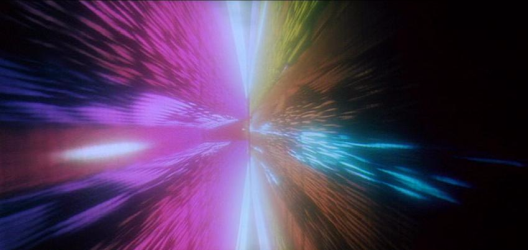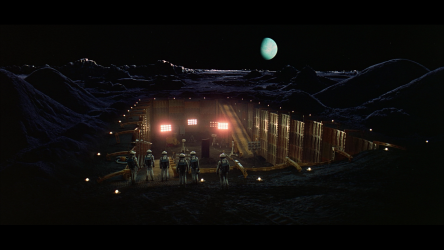It is, perhaps, fitting that our first film of the New Year should be Kubrick’s tale of—wait, what’s this movie about again? And why is it fitting?
Forget it. I’m on a roll.
I’ve never seen this movie. I’ve started a few times, and never made it past the monkeys which constitute part one. This is followed by a cryptic moon investigation. This, in turn, is followed by an expedition to Jupter. And part four…well. At the start of part three, The Flower leaned over to me and said “This movie’s all over the map!”

So many guys in monkey suits, you’d think it was a John Landis film.
It does actually all tie together, though at least one original idea was to have it be a bunch of short stories. The MacGuffin, as it were, is a mysterious black monolith (“The Sentinel”, apparently, though this term is not used in the movie, I don’t think). This shows up at each part of the movie and is the (largely unexplained) catalyst for the various events. In the first part, about 25 minutes long, the monolith apparently bestows enlightenment on some proto-humans. A lot of people miss this.
I think it’s pretty clear but it’s not spelled out. In fact, of the 140+ minutes of the film, nearly 90 are dialogue free. The dialogue-free parts, especially in the beginning, work really well. The special effects, nearly fifty years later, are still pretty astounding, doubtless due in part to Kubrick hiring a battalion of animators to black out any of the tell-tale borders when compositing shots. You can see why people would believe Kubrick faked the moon landing for NASA, but my theory is that Kubrick actually had a space station, and helped NASA to get to the moon to provide cover for his advanced technology.
Prove me wrong.

We’re through the looking glass here, people.
Someone asked me who the stars were in the film, and I realized on seeing it that there’s really only one: HAL. Voiced by veteran actor Douglas Rain, designed by Kubrick and (probably) Douglas Trumbull (who would go on to use his expertise to create Silent Running), the emotionless eye which calmly narrates the deaths of humans is an archetype for non-robotic computers to this day.
The third part of the movie ends up being the strongest thereby: With Keir Dullea’s Dave playing off the mellow, homocidal HAL in a struggle for survival, and set at Kubrick’s tortuous pacing, it is by itself one of the greatest movies in sci-fi movie history.
So, if the first part sets up a mystery, and the second part heightens the mystery and offers some clues, the third act satisfyingly builds to a tremendous climax. Then there’s the fourth act.
Well, look: For the sake of the narrative, you’ve gotta show a human evolving into something as wondrous as an ape evolving into a man. But your audience is chock full of humans! Worse, you’re a human yourself. So, what’s a guy to do? Drop some acid and hope that he remembers what it was like?
I’m not saying that, just because it was 1969, and the last twenty minutes are a sort of psychedelic mysticism that acid was involved. But I’m not not saying it, either.

What the actual F?
Jokes aside, it probably wasn’t. I mean, I don’t know, but if you’re a “control freak” on the level of Kubrick, it’s almost unimaginable to think you’d do something as unpredictable in its effects (including when it might come back to haunt you) as LSD. On the other hand, Trumbull was perhaps a big part of this sequence, so even if Kubrick never dabbled… Hey, I’m not here to judge.
Probably the weirdest thing about this movie is that it does work. I would argue that there’s almost no point in seeing it on the little screen, and that’s why I never managed. I don’t see how you can appreciate the effects, to say nothing of sitting at home for a 2.5 hour movie where 1.5 hours of it are silent. (If you live alone and turn off your devices, and get close enough to the screen: Maybe.)
It often finishes at #1 on “best ever” movie lists, on “best sci-fi”, and so on. I don’t know if I’d agree; that might depend on the day you asked. But the desire to make a non-kitschy, non-kid-flick (though it is rated G) sci-fi film definitely shows, as does the amazing attention to detail typical of Kubrick’s work.
The Flower liked it but wasn’t sure she could watch it right away again (like the other Kubrick films we’ve seen). I don’t know. Maybe. The Boy was sick so it was just the two of us, so we didn’t get his feedback on this one, alas.
Maybe if you’re not feeling super-antsy, this is one to check out.

Pictured: Kubrick explaining to NASA how to get to Jupiter.

2 thoughts on “2001: A Space Odyssey (1969)”